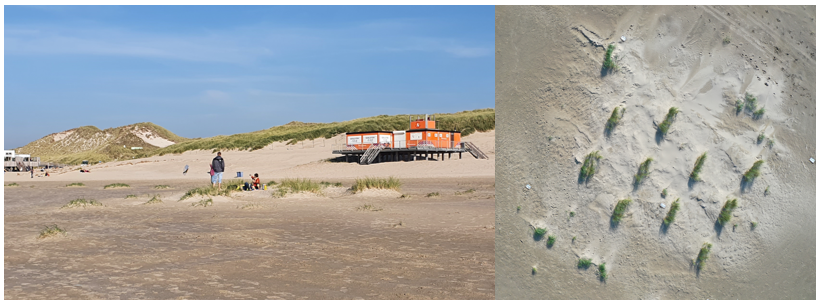S.J. van Rosmalen1*, M.J.P.M. Riksen1, J. Limpens1
1 Wageningen University & Research
*corresponding author:
Pressure on our coastal systems is increasing, both from climate change and anthropogenic factors. The Dutch dune system is heavily managed to ensure flood safety. Yet at the same time the dunes and beach facilitate many other essential functions such as high-quality drinking water and space for recreation. Next to this, it is one of the most biodiverse ecosystems in the Netherlands.
Under climate change warmer and drier summers are expected to occur more frequently and storm intensity to increase. Both are potential detrimental stressors to this coastal system and may interfere with dune development. Early dune development stages such as embryonic dunes may be particular sensitive, as they are located on the upper beach within the range of storm surges and the increased recreational visits to the beach with warmer weather.
The impact of recreation on the mature dune systems has been investigated, here trampling of the vegetation has been found to have a detrimental effect on both vegetation abundance and species richness. Moreover, by vegetation removal it can change the local sediment dynamics. The effects on the highly dynamic embryonic dunes remain unknown. To explore this, artificial embryo dune fields (10x12 m) containing 10 dunes were created on the Sand Engine and at Hargen aan Zee across an anthropogenic pressure gradient in late 2020 and early 2021. In this presentation we show the sediment dynamics and vegetation success which were monitored during the vegetation growing season and the summer recreation season of 2021 to determine how recreation affects embryo dune development.

Figure 1: Recreation in artificial embryo dune field and aerial at Hargen aan Zee.
References
Cheryl McKenna Neuman and Marianne Maljaars Scott. A wind tunnel study of the influence of pore water on aeolian sediment transport. Journal of Arid Environments, 39(3):403–419, 1998. 1.1. https://doi.org/10.1006/jare.1997.0371
Leonardo Duarte-Campos, Kathelijne M Wijnberg, and Suzanne JMH Hulscher. Estimating annual onshore aeolian sand supply from the intertidal beach using an aggregated-scale transport formula. Journal of marine science and engineering, 6(4):127, 2018. 2.3.2. https://doi.org/10.3390/jmse6040127
I. Surname1*, F.N. Another-Surname2 , Y. Next-Surname2
1 University Name, Country; 2 Organization Name, Country
* Corresponding author: mail.name@organization.org


